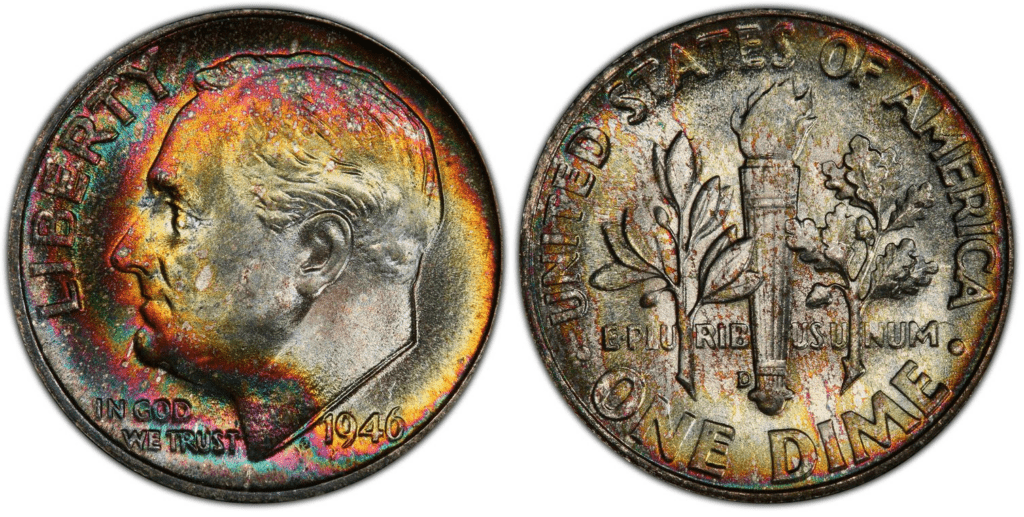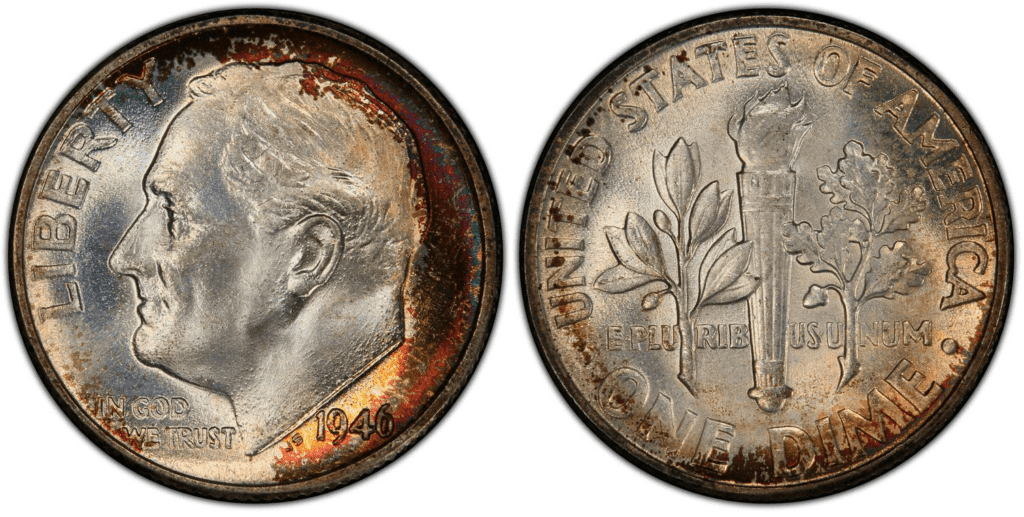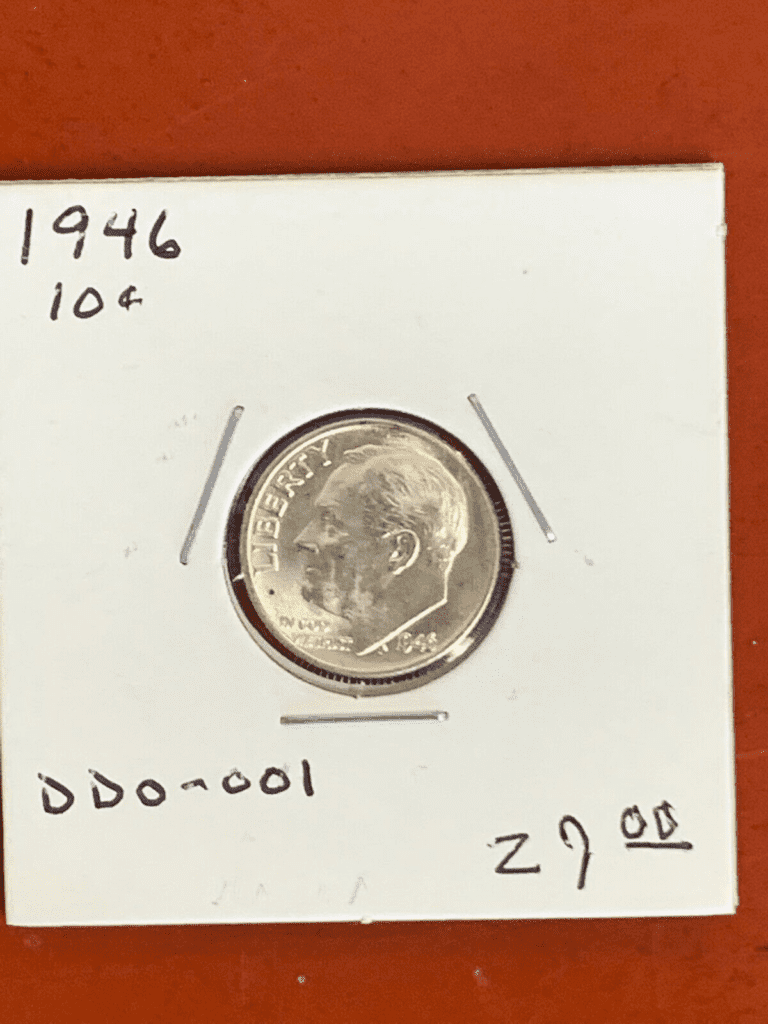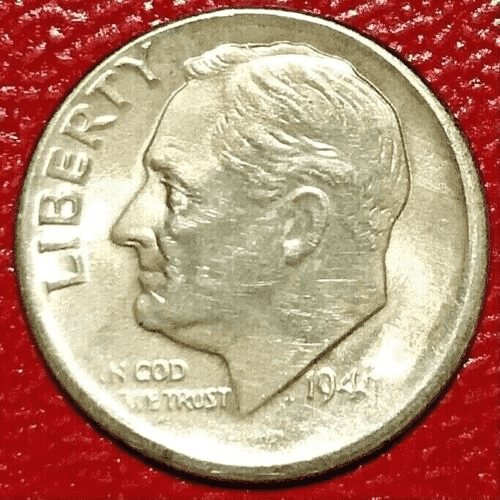What Is the 1946 Roosevelt Dime Made Of?
Did you know that after being in circulation for 29 years, the Mercury Dime (also referred to as the Winged Liberty Head dime) was replaced by the Roosevelt Dime in 1946? Yet, interestingly, the Roosevelt dime is still being struck and released for circulation.
This article guide discusses the Roosevelt dime’s composition, history, varieties, price value, and more. So, just read on to learn more about the coin first produced and released in 1946.
The 1946 Roosevelt dime, or a ten-cent piece, has a face value of 0.10 US dollars. The dime is composed of 90% silver and 10% copper. If you look at the coin, it has a reeded edge, with 17.91 mm in diameter and a mass of 2.5 g. The exact composition and specifications were used for the Roosevelt dimes produced from 1947 to 1964.
President Roosevelt is known for his war leadership. He led the United States through the Great Depression and World War II. He suffered from polio since 1921 but was strongly supported by the March of Dimes to help fight the crippling disease.
So after he died on April 12, 1945, the Department of Treasury decided to put the late President on the dime to honor him. And on January 19, 1946, the Philadelphia Mint started producing the Roosevelt dime. Then on January 30, 1946, which would have been Roosevelt’s 64th birth anniversary, the Mint released the dime into circulation.

The 1946 Roosevelt dime’s design was commissioned to the Chief Engraver John R. Sinnock. So in October 1945, Sinnock submitted the plaster models to the Commission of Fine Arts, whose work was also approved in the same year.
On the obverse side of the coin (heads), you can see Roosevelt’s bust facing left with the following inscriptions:
- LIBERTY
- IN GOD WE TRUST
- JS – John Sinnock’s initials, found at the cutoff of the bust to the left side of the year
- 1946
Meanwhile, the reverse side (tail) depicts a torch in the center, representing liberty. It is also flanked by an olive spring as a symbol of peace and an oak that symbolizes strength and independence. This side of the coin also shows the following inscriptions:
- UNITED STATES OF AMERICA
- E PLURIBUS UNUM
- ONE DIME
The design for having Roosevelt on the coin was impressive to many as it came out clean and modest yet showed a taste of grandeur.
1946 Roosevelt Dime Varieties
1946 was the beginning year of the Roosevelt series. Since then, the United States Mint has continually produced the ten cents. The mints at Denver, Philadelphia, and San Francisco struck 344 million coins in just 1946 alone.
Despite being produced and collected in millions, only a portion of these coins had been preserved in excellent condition. So naturally, this makes it sought after by coin collectors.
The three known varieties of the 1946 Roosevelt dime are 1946-D, 1946-P, and 1946-S. The Mint also produced error coins out of the massive 344 million productions of these coins.
You can take a look at the descriptions of each of the three varieties below and details of the error coins that were made:
1946 D Roosevelt Dime
Edge: Reeded
Mint Mark: D – found on the reverse side, the bottom left side of the torch
Place of minting: Denver
Year of minting: 1946
Face Value: $0.10 (ten cents)
Price: $7 to $26 (or more)
Quantity produced: 61,043,500
Designer: John R. Sinnock
Composition: 90% Silver, 10% Copper
Mass: 2.50 grams
Diameter: 17.91 mm

Being the first year to produce the Roosevelt dime, the Denver mint struck more than 61 million coins in 1946. The largest mintage of the three. Due to this massive production, only coins with MS66 condition were somewhat scarce, with several thousand samples existing.
Coins in MS67 grade are considered to be very scarce, with just over 200 pieces available and none with fine grades.
1946 P Roosevelt Dime
Edge: Reeded
Mint Mark: No mint mark
Place of minting: Philadelphia
Year of minting: 1946
Face Value: $0.10 (ten cents)
Price: $11 to $16 (or more)
Quantity produced: 255,250,000
Designer: John R. Sinnock
Composition: 90% Silver, 10% Copper
Mass: 2.50 grams
Diameter: 17.91 mm

During the first year of the production of the Roosevelt Dime, the Philadelphia Mint produced the most coins, with over 255 million released into circulation. Given this number, it is understandable that finding the 1946-P variety in circulated conditions is relatively easy.
Though for its MS65 and higher grades, these are considered somewhat challenging to find. Possibly for its MS67 grade, which is scarce, only fewer than 250 samples exist. For the record, PCGS graded only one piece for its MS68 grade.
1946 S Roosevelt Dime
Edge: Reeded
Mint Mark: S – found on the reverse side, bottom left side of the torch
Place of minting: Denver
Year of minting: 1946
Face Value: $0.10 (ten cents)
Price: $14 to $59 (or more)
Quantity produced: 27,900,000
Designer: John R. Sinnock
Composition: 90% Silver, 10% Copper
Mass: 2.50 grams
Diameter: 17.91 mm

San Francisco struck Roosevelt dimes short of 28 million out of the three Mints in 1946. This is the least number of coins produced by far. Regarding scarcity, 1946-S Roosevelt Dime is considered common in circulated conditions. In the MS64 grade, they are somewhat scarce, and in the MS65 grade, they are a little scarcer, though still available with a slight premium.
Coins in MS66 grade are scarcer, with perhaps almost 2000 existing. Also, with less than a thousand samples, coins in MS67 grade are challenging to find.
List Of 1946 Roosevelt Dime Errors
Coins exhibiting errors are considered to be unique and distinct. These error coins are produced during minting. The error could be due to different reasons. Most equipment could become overworked over time as it is used for massive productions. Some factors like human errors or a deteriorating or malfunctioning machine also contribute to the errors.
However, the error coins produced are still attractive to many coin collectors. Since these are special coins, collectors are fascinated with the unique outcome because they can sell them reasonably in the market.
During minting, different types of errors can occur. Some known errors that can happen during minting are clipped planchet, die crack, rotated die, doubled die, blank planchet, lamination error, off-center strike, and broadstrike.
Let’s see some samples of the errors that occur in some of the 1946 Roosevelt Dime below:
Die Crack

The sample above is a result of a die crack. It shows that a planchet has a crack on its collar. In this example, the crack is found on the rim near the year. Usually, dies with cracks, particularly those with cracks near the edge, break. You can observe that a broken piece may be retained in position or fall away.
Doubled Die

The sample above has a doubled die error, which is visible to the naked eye. When the die or hub misaligns during the hubbing process, it can create duplicate design elements. Doubled die strength varies from very light, isolated to extreme and widespread.
Misaligned Die/Broadstrike Errors

If you look at the sample above, you can see it is off-centered. When the hammer die is not centered over the anvil die, it results in an off-centered obverse. Broadstrike error also occurs when the circular die that surrounds the lower die (collar die) malfunctions.
As a result, the planchet’s metal is prevented from flowing outside the confines of the die. As a result, coins with broadstrike errors usually have plain edges.
How Much Is the 1946 Roosevelt Dime Worth Today?
Today, a 1946 Roosevelt Dime is approximately between $2.25 and $2.75 in circulated condition. However, in pristine and uncirculated condition, the 1946 Dimes could be sold for as much as $1350. This price is based on the price guide of NGC.
As for its melt value, since it is made of silver and copper, the 1946 Roosevelt dime is based on the value of these metals. Approximately, the melt value of a 1946 Roosevelt dime is $1.7375.
The value of the 1946 Roosevelt dime generally depends on its condition, where it is minted, its grade, and its rarity. Let’s examine the below to get an idea of the value of the 1946 dime:
| Coin | Condition | Grade | Mintage | Value |
| 1948 D Roosevelt Dime | Circulated/Mint | Not graded | 52,841,000 | $2.25 to $2.75 |
| 1948 D Roosevelt Dime | Uncirculated/Mint | MS-66 | 52,841,000 | $8 to $27 |
| 1948 D Roosevelt Dime | Uncirculated/Mint | MS-67 | 52,841,000 | $21 to $115 |
| 1948 D Roosevelt Dime | Uncirculated/Mint | MS-68 | 52,841,000 | $528 to $870 |
| 1948 D Roosevelt Dime | Full Band | MS-68 | 52,841,000 | $720 to $4,230 |
| 1948 S Roosevelt Dime | Circulated/Mint | Not graded | 35,520,000 | $2.20 to $2.70
|
| 1948 S Roosevelt Dime | Uncirculated/Mint | MS-66 | 35,520,000 | $15 to $63 |
| 1948 S Roosevelt Dime | Uncirculated/Mint | MS-67 | 35,520,000 | $25 to $135 |
| 1948 S Roosevelt Dime | Uncirculated/Mint | MS-68 | 35,520,000 | $588 to $1,840 |
| 1948 S Roosevelt Dime | Full Band | MS-68 | 35,520,000 | $480 to $1,320 |
| 1948 P Roosevelt Dime | Uncirculated/Mint | Not graded | 74,950,000 | $5.81 to $14
|
| 1948 P Roosevelt Dime | Uncirculated/Mint | MS-67 | 74,950,000 | $26 to $61 |
| 1948 P Roosevelt Dime | Uncirculated/Mint | MS-68 | 74,950,000 | $588 to $2,588 |
| 1948 P Roosevelt Dime | Uncirculated/Mint | MS-69 | 74,950,000 | $12,650 |
| 1948 P Roosevelt Dime | Full Band | MS-68 | 74,950,000 | $1,528 to $8,625 |
As you can see, the 1946 dime can be valued more than its face value or melt value. To see how much the dime has been sold in the past, check out these auction records for each variety:
- $10,869 – a 1946 10C, FB (Regular Strike) coin with a grade of MS68FB sold on October 2015 by Legend Rare Coin Auctions
- $5,819 – a 1946-S 10C, FB (Regular Strike) coin with a grade of MS68 sold on February 2007 by Bowers & Merena
- $4,888 – a 1946-D 10C, FB (Regular Strike) coin with a grade of MS68 sold on July 2007 by Heritage Auctions
How Does The Grading System Work?
The Sheldon Scale is used by numismatists to provide a numerical value to coins. The Sheldon Scale goes from poor (P-1) to perfect mint state (P-1) (MS-70). Coins were originally evaluated using words to reflect their condition (Good, Fair, Excellent, Etc.). Unfortunately, coin collectors and dealers had different ideas about what each of these terms represent.
Professional numismatists joined together in the 1970s and established CoinGrading standards. These numismatists now assign grades at key places on the seventy-point scale, using the most regularly utilized numeric points in conjunction with the original adjective grade. The following are the most common coin grades:
-
-
- (P-1) Poor – Indistinguishable and probably damaged; if used, must have a date and mintmark; otherwise, rather battered.
- (FR-2) Fair – Nearly smooth, but without the damage that a coin graded Poor often possesses. The coin must have enough detail to be identified.
- (G-4) Fair – Inscriptions have merged into the rims in some areas, and important elements have been mostly erased.
- (VG-8) Very Good- A little weathered, but all of the primary design elements are visible, albeit faintly. There is little if any, central detail left.
- (F-12) Good – The item is very worn, yet the wear is even, and the overall design details stand out clearly. Rims are almost completely isolated from the field.
- (VF-20) Very Fine – Moderately weathered, with some finer features still visible. The motto or all letters of LIBERTY are readable. Both sides of the coin have entire rims that are separated from the field.
- (EF-40) Extremely Fine – Gently used; all gadgets are visible, and the most important ones are bold. The finer details are bold and clear, however, light wear may be seen.
- (AU-50) Uncirculated – Slight evidence of wear on the coin’s design’s high points; may have contact marks; eye appeal should be adequate.
- (AU-58) Uncirculated Choice – Slight traces of wear, no severe contact marks, almost full mint shine, and great eye appeal.
- (MS-60) Mint State Basal – Strictly uncirculated; no indication of wear on the coin’s highest points, but an unsightly coin with reduced luster, visible contact marks, hairlines, and other flaws.
- (MS-63) Mint State Acceptable – Uncirculated, but with contact scratches and nicks, little reduced shine, but otherwise appealing appearance. The strike is weak to average.
- (MS-65) Mint State Choice – Uncirculated with great mint shine, very little contact blemishes, and exceptional eye appeal. The strike is unusually severe.
- (MS-68) Mint State Premium Quality – Uncirculated with superb luster, no obvious contact marks to the naked eye, and exceptional eye appeal. The strike is quick and appealing.
- (MS-69) Almost Perfect Mint State – Uncirculated with perfect brilliance, a sharp and appealing strike, and extremely good eye appeal. A near-perfect coin with minor imperfections in the planchet, strike, and contact markings (seen only under 8x magnification).
- (MS-70) Mint State Perfect – Under 8x magnification, there are no tiny imperfections discernible; the strike is crisp, and the coin is perfectly centered on a beautiful planchet. Rarely seen on a coin, this coin is bright and whole, with original luster and exceptional eye appeal.
-
Where To Buy Or Sell 1946 Roosevelt Dime?
The easiest way to buy or sell a 1946 Roosevelt coin is online. Online stores like eBay, Etsy, and Amazon offer these coins. In addition, you can register on these sites to offer your 1946 Dime collections. Just ensure to have your collections graded before putting them on sale.
If you prefer physical stores, you can buy or sell your rare 1946 Roosevelt for ten cents to pawn shops or antique stores. Coin shops and auction houses can also be your options.
Professionals from PCGS and NGC can also help if you need advice on how and where to go about buying or selling your 1946 Roosevelt coins.
FAQs
What is the silver content of a 1946 dime?
The 1946 Roosevelt Dime comprises 90 percent silver and 10 percent copper.
How much is a 1946 Dime without a mint mark worth?
1946 Dimes struck in the Philadelphia Mint don’t have a mint mark. However, with over 255 million coins produced at the Mint, we could say that these coins are not hard to find. Its value depends on its mintage, rarity, and condition. Approximately, the 1946-P variety at around $1.50 to $3.00.
Which dimes are worth over $100?
There are still 1946 Roosevelt dimes that could be worth over $100, but these coins are primarily in MS67 grade and higher. These varieties are generally scarce. The price of a 1946 dime will be based on its general condition and mintage.
